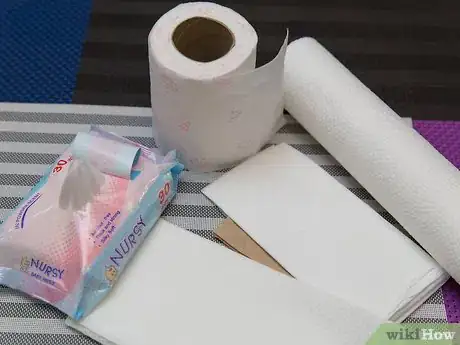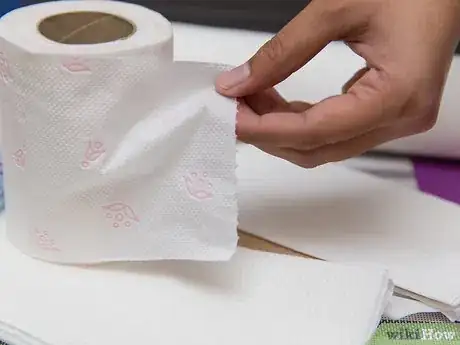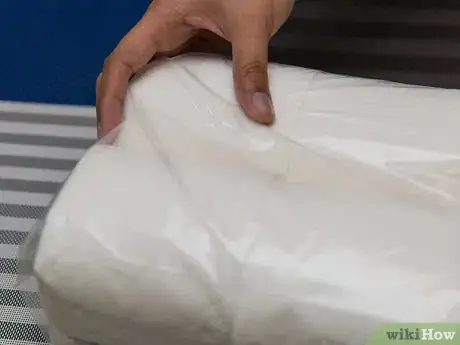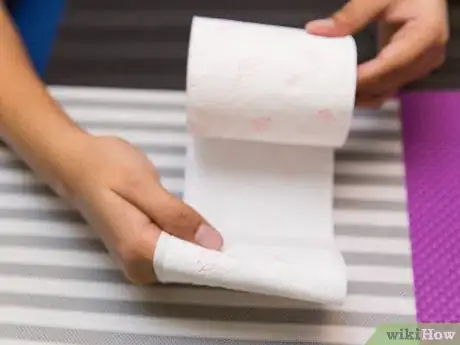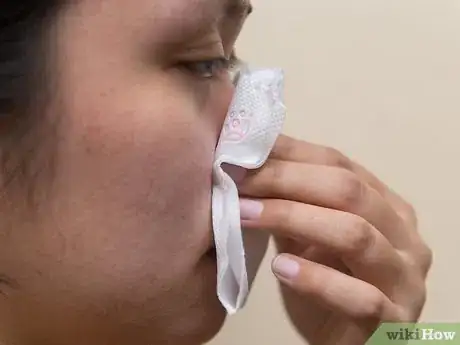X
This article was medically reviewed by Jennifer Boidy, RN. Jennifer Boidy is a Registered Nurse in Maryland. She received her Associate of Science in Nursing from Carroll Community College in 2012.
This article has been viewed 77,119 times.
Tissues are used to remove mucus—commonly called snot—from your nose. You should choose a tissue based on your needs and then practice proper use. Continue below to learn how.
Steps
Method 1
Method 1 of 2:
Choosing the Right Tissue
-
1Evaluate your needs. The tissue type you choose depends on your current needs. Spend some time considering why you need tissues.
- If you have a cold, heavy-duty tissue may be necessary. You can also consider softer tissues or tissues that use aloe vera or lotion. This can prevent chafing.
- If you're just using tissue for day-to-day allergies and occasional nose blowing, you can probably opt for a cheaper brand without any special lotions or creams.
-
2Review tissue types. There are many different types and brands of facial tissues. Spend some time evaluating tissue types before making a decision.Advertisement
-
3Watch out for sales. If you're simply looking for tissues for day-to-day use, you might just want to buy tissue at sales prices. Keep your eyes peeled at the supermarket. You can also look for coupons in your local newspaper. If tissues are being sold in bulk prices, like 10 boxes for $10, it might be a good idea to stock up so they'll last you awhile.
Advertisement
Method 2
Method 2 of 2:
Using Tissue
-
1Use the tissue properly. Once you've selected your tissue type, you can begin to use your tissue. Using a tissue is fairly simple. With the tissue in your hand, place it under your nose to catch the mucus. Hold one finger over one nostril and push air out of the opposite nostril until your nose is clear. Then, repeat on the opposite side. This may take more than one tissue. Fold up the tissue before you discard it.
- If you have a particularly harsh cold, consider folding the tissue in half or using two tissues to blow your nose. This can protect your hands from germs.
- If you use the tissue to dab your nose, do so gently. When dabbing up mucus, use light dotting motions instead of rubbing, which causes friction and irritation.
- Always dispose of tissues after using them, especially when you have a cold.
-
2Know the proper times to use a tissue. Understand when you should use a tissue. Tissues can be used to help clear mucus and also to prevent the spread of colds.
- If you have a cold or flu, you can dramatically reduce the risk of it spreading through proper tissue use. Exposure to airborne germs is the number one cause of colds.
- If you have a cold, use a tissue each time you sneeze and cough in public to fully cover your nose and mouth.[3]
- At home, blow your nose as often as you see fit. Germs and bacteria that cause colds are expelled from the body through snot and mucus.[4]
-
3Carry extras on hand when you have a cold. You can buy travel sized containers of tissue at your local supermarket. Keep these in your purse or pocket so you always have a tissue on hand in public.
-
4Wash your hands frequently when sick. If you have a cold, or if there's a cold going around your school or office, wash your hands frequently. This can help prevent the spread of germs. You should also wash your hands frequently when out in public to keep yourself from picking up a cold, especially during cold and flu season.
- Scrub your hands for 20 seconds with soap and water. Rinse your hands thoroughly in lukewarm, clear running water.[5]
- Wash your hands before touching your nose, eyes, or mouth. If you wear contacts, always wash your hands before handling or removing them.[6]
- You should also wash your hands after blowing your nose or coughing into them.
- If you don't have easy access to soap and water, carry an alcohol-based hand sanitizer with you.
-
5Know when to see a doctor. The common cold does not usually warrant medical attention. However, if your symptoms persist for more than a couple of weeks and if you develop a high fever, blurred vision, nausea, or other symptoms make an appointment with your doctor.[7]
- See a doctor if you regularly see blood in your mucus, or if your mucus is thick and green. You might have a sinus infection (sinusitis).[8]
Advertisement
Warnings
- Never use the same tissue with which you blew your nose to wipe a tear from your eye. That will only spread germs.⧼thumbs_response⧽
Advertisement
References
- ↑ http://www.businessinsider.com/consumer-reports-the-best-facial-tissues-2013-7
- ↑ http://www.businessinsider.com/consumer-reports-the-best-facial-tissues-2013-7
- ↑ http://www.dailymail.co.uk/health/article-1092075/Use-tissue-How-just-sneeze-infect-150-people.html
- ↑ http://www.dailymail.co.uk/health/article-1092075/Use-tissue-How-just-sneeze-infect-150-people.html
- ↑ http://www.cdc.gov/features/rhinoviruses/
- ↑ http://www.cdc.gov/features/rhinoviruses/
- ↑ http://www.cdc.gov/features/rhinoviruses/
- ↑ http://www.webmd.com/cold-and-flu/cold-guide/cold-becomes-sinus-infection#1
About This Article
Advertisement
